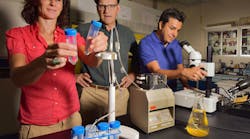Power plants draw more freshwater than any other consumer in the U.S., accounting for more than 50% of the nation’s freshwater use (or about 500 billion gallons daily). To cut down on this use, researchers at Sandia National Laboratories developed a silica filter for power-plant cooling water; it decreases the amount of freshwater power plants consume by increasing the number of times cooling-tower water can be reused and recycled.
Power plants already recycle freshwater, but the number of times a batch of water can be reused is limited by the amount of silica that builds up with each cycle. Some water evaporates during the cooling process in the water towers, but the minerals in the water—including silica—build up with each cycle.
Silica is a common, naturally occurring substance in freshwater and has limited solubility. It is prone to forming scales on turbines, boilers, heat exchangers, transfer pipes, and other equipment. This buildup leads to equipment malfunctions by causing clogs and corrosion, as well as interfering with heat transfer, and is costly to prevent. The cost to treat and recycle water used at power plants is estimated to be 1.5 to 2 times the cost of freshwater, often because of the high price of the current methods used to remove silica.
The Sandia research team created filters made of pellets and powders out of hydrotalcite, a layered material consisting of aluminum hydroxide. Water flows through or over the material during filtration, and silica in the water crystalizes and remains in the filter while cleaner water flows out.
The researchers found that the hydrotalcite filters could remove about 90% of accumulated silica in recycled water, and the water could then be reused for five or more cycles The goal is to come up with a filter that will let the water be recycled and reused 10 times. This could save both money and natural resources.
In addition to studying the material and its effectiveness, the team wanted to determine how to best scale up the new filtration so it would be viable for large-scale operations at power plants. “The measurements we do here are in beakers the size of a coffee cup,” noted one researcher, “but when you’re at a facility like a power plant that uses a million gallons a day, you want to know if hydrotalcite will be effective at that level.”
“A lot of the industry will already have a silica removal process that works, but it may not work well,” Nenoff said. “As a result of this project, we’ll be able to give them an estimated cost and energy savings, and even a projected lifetime savings that hydrotalcite could provide over their current method. That sort of modeling and analysis provides more incentive to take the risk of implementing a new method.

